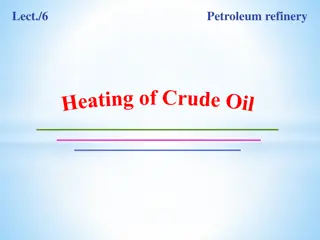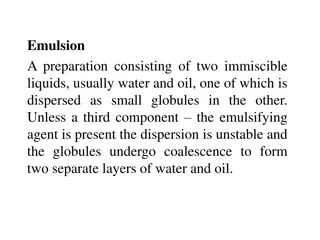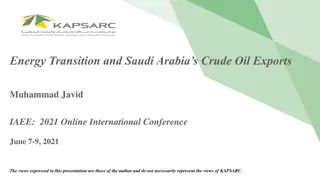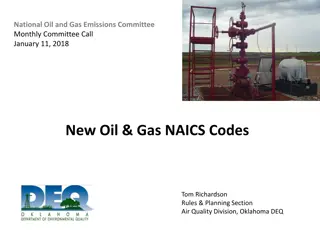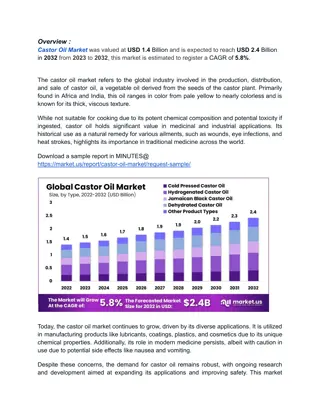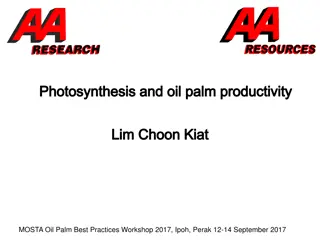The Chemistry and Composition of Crude Oil
Crude oil, also known as petroleum, is a complex mixture of hydrocarbons and other compounds like sulfur, nitrogen, and metals. The composition of crude oil includes aliphatics, aromatics, naphthenes, and other elements, each playing a unique role in its properties and characteristics. This article delves into the fascinating world of crude oil chemistry, from paraffins to olefins, naphthenes, and aromatics, shedding light on their roles and importance in the oil industry.
Download Presentation

Please find below an Image/Link to download the presentation.
The content on the website is provided AS IS for your information and personal use only. It may not be sold, licensed, or shared on other websites without obtaining consent from the author.If you encounter any issues during the download, it is possible that the publisher has removed the file from their server.
You are allowed to download the files provided on this website for personal or commercial use, subject to the condition that they are used lawfully. All files are the property of their respective owners.
The content on the website is provided AS IS for your information and personal use only. It may not be sold, licensed, or shared on other websites without obtaining consent from the author.
E N D
Presentation Transcript
CRUDE OIL CHEMISTRY AND COMPOSITION 1
CONTENT 1. INTRODUCTION 2. Composition of Crude Oil 3. Crude chemistry i. Olefins ii. Naphthenes iii. Aromatics iv. Napthalenes v. Asphaltenes 4. Characterization Factors 2
INTRODUCTION - Petroleum (also called crude oil) is a naturally mixture of hydrocarbons, generally in the liquid state, that may also include compounds of sulfur, nitrogen, oxygen, and metals and other elements (ASTM D-4175). Inorganic sediment and water may also be present. The elementary composition of crude oil usually falls within the following ranges: 3
Composition of Crude Oil - CRUDE OIL HYDROCARBONS NON-HYDROCARBONS ALIPHATICS AROMATICS NAPHTHENES SULFURS NITROGENS OXYGENS METALLICS 25% 17% 50% <8% <1% <3% <100PPM O C1 - C60 (C6H5)n CYCLOALKANES SH N H COOH S 4
Crude chemistry Paraffin: Paraffin refer to alkanes such as methane, ethane, propane, n and iso butane, n and iso pentane. These compounds are primarily obtained as a gas fraction from the crude distillation unit. 5
Olefins Alkenes such as ethylene, propylene and butylenes are highly chemically reactive. They are not found in mentionable quantities in crude oil but are encountered in some refinery processes such as alkylation. 6
Naphthenes Naphthenes or cycloalkanes such as cyclopropane, methyl cyclohexane are also present in the crude oil. These compounds are not aromatic and hence do not contribute much to the octane number. Therefore, in the reforming reaction, these compounds are targeted to generate aromatics which have higher octane numbers than the naphthenes. 7
Aromatics Aromatics such as benzene, toluene o/m/p-xylene are also available in the crude oil. These contribute towards higher octane number products and the target is to maximize their quantity in a refinery process. 8
Napthalenes Polynuclear aromatics such as naphthalenes consist of two or three or more aromatic rings. Their molecular weight is usually between 150 500. Organic sulphur compounds Organic sulphur compounds such as thiophene, pyridine also exist in the crude oil. The basic difficulty of these organic sulphur compounds is the additional hydrogen requirements in the hydrotreaters to meet the EURO 5 standard. Oxygen containing compounds These compounds do not exist 2 % by weight in the crude oil. Typical examples are acetic and benzoic acids. These compounds cause corrosion and therefore needs to be effectively handled. 9
Asphaltenes Asphaltenes are polynuclear aromatic structures consisting of 20 or more aromatic rings along with paraffinic and naphthenic chains. A crude with high quantities of resins and asphaltenes (heavy crude) is usually targeted for coke production. Resins Resins are polynuclear aromatic structures supported with side chains of paraffins and small ring aromatics. Their molecular weights vary between 500 1500. These compounds also contain sulphur, nitrogen, oxygen, vanadium and nickel. 10
Characterization Factors There are several correlations between yield and the aromaticity and Paraffinicity of crude oils, but the two most widely used are - The UOP or Watson characterization factor (KW) The U.S. Bureau of Mines correlation index (CI). The UOP Characterization Factor, commonly called KUOP, is indicative of the general origin and nature of a petroleum stock. This factor correlates boiling point with specific gravity, according to thee following expression. 11
THANK YOU 12

 undefined
undefined

 undefined
undefined

